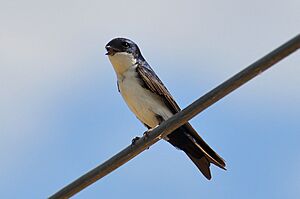Blue-and-white swallow facts for kids
Quick facts for kids Blue-and-white swallow |
|
|---|---|
 |
|
| In Rio Grande do Sul, Brazil | |
| Conservation status | |
| Scientific classification | |
| Genus: |
Pygochelidon
|
| Species: |
cyanoleuca
|
 |
|
| Range map of Blue-and-white Swallow (Pygochelidon cyanoleuca) Breeding Year-round Non-breeding | |
| Synonyms | |
|
Hirundo cyanoleuca Vieillot, 1817 |
|
The blue-and-white swallow (Pygochelidon cyanoleuca) is a small bird known for its quick flight. It lives in many parts of South America. You can find it from Nicaragua all the way south. However, it does not live in deserts or the Amazon Basin.
Some blue-and-white swallows are migratory. This means they fly to warmer places for winter. They might travel as far north as Trinidad.
Contents
About the Blue-and-white Swallow
This section tells you more about how the blue-and-white swallow was named. It also explains how scientists classify this bird.
Naming the Swallow
The blue-and-white swallow was first officially described in 1817. A French ornithologist named Louis Pierre Vieillot gave it the name Hirundo cyanoleuca. He thought the bird came from Paraguay. The scientific name cyanoleuca means "blue and white," just like its English name.
How Scientists Classify Them
This bird used to be in a group called Notiochelidon. But after a study in 2005, scientists moved it. Now, it belongs to the group Pygochelidon. This group was brought back into use.
There are three main types, or subspecies, of the blue-and-white swallow:
- P. c. cyanoleuca: This type lives from Costa Rica through northern and central South America.
- P. c. peruviana: This type is found only in western Peru.
- P. c. patagonica: This type lives in southern South America.
What Does the Blue-and-white Swallow Look Like?
Learn about the size, colors, and sounds of this interesting bird.
Size and Colors
An adult blue-and-white swallow is usually about 11 to 12 centimeters (4.3 to 4.7 inches) long. It weighs around 10 grams (0.35 ounces). Its upper body is a dark blue color. Its belly and chest are white. The feathers under its wings and tail are blackish. Its tail is short and slightly forked.
Young swallows look a bit different. They are brown on top and have a buff (light yellowish-brown) tint underneath. Their tails are also less forked than adults.
Their Call
The blue-and-white swallow makes a distinct sound. Its call is a buzzing dzzzhreeee.
Different Subspecies Appearance
The three subspecies have slight differences:
- The P. c. cyanoleuca type is found from Nicaragua and Trinidad down to Argentina, Paraguay, and Uruguay.
- The P. c. patagonica type is larger, about 13.5 centimeters (5.3 inches). It has paler underwings and white feathers under its tail. This type is migratory.
- The P. c. peruviana type lives only along the coast of Peru, up to 2,500 meters (8,200 feet) high. It is smaller than patagonica. It has less white under its tail, darker underwings, and darker sides.
Where Do Blue-and-white Swallows Live?
Find out about the places where these birds make their homes.
This swallow prefers open areas. You can often see them in villages and towns. They also live on farms and in clearings within forests. In Central America, they like to live in high mountain areas. But in other places, they can be found from lowlands up to 4,000 meters (13,000 feet) high.
How Do Blue-and-white Swallows Live?
This section explores their daily life, what they eat, and how they fly.
Social Life and Diet
When they are not breeding, blue-and-white swallows often gather in small groups. They mainly eat insects. They catch these insects while flying in the air. Sometimes, you can see them gathering where termites are swarming.
Flight and Perching
Their flight is usually fluttery and quick. These swallows often perch, or rest, on wires or tree branches.
Breeding and Nests
Both parent swallows work together to build their nests. They make a shallow nest out of straw. They build these nests in many different places. This includes natural spots like tree holes and rock crevices. They also use man-made places like bridges.
The female lays eggs, and the number can vary. In the southern parts of their range, they can lay up to six white eggs. In the northern parts, they usually lay two or three eggs. Both parents take turns sitting on the eggs for about 15 days until they hatch.
After hatching, both parents feed the baby birds. The young swallows stay in the nest for about 26 days until they can fly. Even after they can fly, they often return to the nest to sleep with their parents for up to two months. A pair of swallows might raise two groups of babies in one season.
Are Blue-and-white Swallows Doing Well?
This bird is very common and well-liked. It has actually benefited from human changes to the land. When forests are cut down and towns are built, it creates more open spaces. This gives the swallows more suitable places to live and more food. Because of this, the IUCN (International Union for Conservation of Nature) does not consider them to be in danger.


